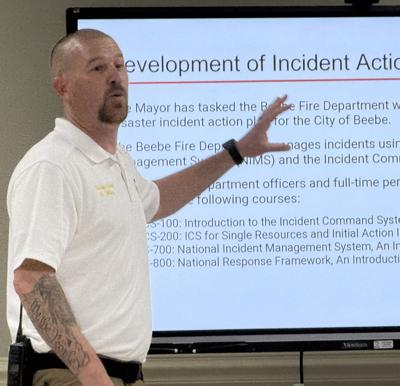Beebe officials discussed the city’s incident action plan for a natural disaster at last week’s Beebe City Council meeting, with Beebe Volunteer Fire Department Battalion Chief Brian Mills saying the city has to have a unified command center as the priority.
Mills said his department was tasked by Mayor Mike Robertson with the development of an action plan for the city. “We go over our incident action plans for natural disasters at least once a year within the fire department.”
He said that the No. 1 thing is establishing “unified command so that multiple departments and or agencies, whether that’s the street department, water department, police department department or agencies such as FBI, [White] County [Office of Emergency Management], it’s unified command. And all I’m saying is that we can’t have four or five people calling the shots and doing their own thing all over town because it doesn’t work that way. It’s unified command, one command center.”
Mills said that the fire department is “99 percent of the time ... going to have the lead if we have a natural disaster such as an ice storm [or] just straight-line winds.”
He said that happened a couple of weeks earlier during tornadic weather in the state. “It [the plan] grows and expands as you need to, but we had I think it was seven or eight incidents at the exact same time. We had trees down going toward Ward. Had trees down on Brock Road. We had a wreck on [U.S.] Highway 64. We had a tree down over behind Ace Hardware. All of that was going on at the same time.”
He said the “fire department came together to set up our operations center there. We called for county to clear the one out out on Brock Road. The Beebe fire department manages all of our incidents. Every incident we use these guidance/policies from the National Incident Management System and the Incident Command System.”
He said that all Beebe Volunteer Fire Department officers and full-time personnel are required to completed courses on ICS-100, Introduction to the Incident Command System; ICS-200, ICS for Single Resources and Initial Action Incidents; IS 700, National Incident Management System, An Introduction; and IS-800, National Response Framework, An Introduction.
Each incident has an incident commander to manage operations, Mills said. “They are running the tracking system. They are the communication piece and not the sole decision-maker. The mayor and others manage future operations.”
“We typically know when we are in danger of bad weather,” he said. “We get weather forecasts from smartphones – it’s very easy, so we do. Everybody for the most part monitors weather forecasts and you know when we are under threat, most of the time. Knowing that, we take our own precautions, our own pre-steps of the incident, and that can be full-time firefighters, we have drones, we have full-time firefighters, we notify them” that they are on call “for recall because they will know to be on standby.”
Staging of equipment was discussed by Mills. Fire equipment is checked every day at the department. Chainsaw blades will be sharpened if there are tornadoes or an ice storm coming through. He said the police department is doing the same type of things getting ready if the city is under a bad threat.
Coordination is done among the mayor’s office, city departments and the White County Office of Emergency Management. The street department makes sure everything is ready, including the backhoes being gassed up, he said.
Once an incident is over, Mills said a “post-incident report” has to be completed. For example, he said if the city were to be hit by a large tornado, “we have to roll up every man hour, every resource used, everything on there, we have to roll that document into one packet that has to go. It is one packet and the only way to track everything is to have one command post and work out of unified command on there.”
Identifying post-incident priorities consists of primary and secondary items. For example, it may be known that certain streets have to be cleared to get ambulances into town. If a neighborhood is hit by a tornado, Mills said it is now known that some search and rescue and door-to-door checking will need to be coordinated.
Mills said he was in the National Guard for 27 years and how the process works for requesting additional resources or manpower is that the mayor goes through the county office of emergency management, which goes through the Arkansas Department of Emergency Management, which then it goes through the governor’s office. Then it would be decided if the National Guard needs to be called in or maybe a situation might call for calling in a hazardous materials team from Searcy or calling in a specific search and rescue team or water rescue. The importance of information sharing was mentioned.
Mills said there will be times when a bunch of firefighters come to the station and will just be waiting because they know “we’re going to have something.”
“Right off the bat our primary location would be at the fire station or a designated area,“ Mills said. “Again, the incident commander is there. His job is to manage the current operations and log and track manpower and resource use for the post-incident report.
“That is a huge priority and function that has to be done at the command post, and the incident commander is responsible for tracking and logging everything that we did, every tree that went to it, how many people responded to it, how much gas did you use, how much water did you use and how many people were there for how long.”
If it is a large-scale incident that continues to grow, Mills said the request will be for city departments to be represented, like the police department, water department or street department. A representative from each department would need to be on the scene.
Each call related to an incident goes from dispatch to the incident commander. Then, the incident commander tells the city departments what is being reported. If there is looting, that is a police function. Police could be sent to where the looting is going on. If there is a water main break, the incident commander would tell the water department head and that would be passed to that department.
In addition to the incident commander, there is an operations commander for the fire department. The department has a second frequency it can use during emergency to help with communication. He said dispatch also can make a list of areas where trees are down rather than just reporting every single tree that is down. “We know what we need to do,” Mills said.
“We cannot just have volunteers just go do their own thing,” he said. “It just cannot be without going through the command post. A big thing we have to do is evaluate what they can do, what type of equipment they have.” He said working with the fire department is absolutely necessary because ultimately it is the department’s responsibility to make sure things are done right, especially cutting around power lines.
“Normally, we have a lot of volunteers show up,” he said. He recalled a storm in 2011 or 2012 where trees were cut down for two or three days and lots of volunteers showed up. Mills said these volunteers came to the fire department asking what they could do.
Robertson said area churches are good when it comes to volunteering in times of need, like weather events. Churches, he said, have set up shelters in the past and “we saw all the churches setting up for food and water.”
Robertson said the city spent $400,000 cleaning up after a straight-line wind event once. Private contractors had to be brought in, including dump trucks. “We had to have a record of everything to recoup that money. You get it back if you have good records. In general, all of our departments are well-versed in this. I think we have a good plan and we can expand on that.”
Beebe Fire Chief William Nick said that the lesson learned from the 1999 tornado that struck Beebe “is that we got to keep records. We want to recoup that money. I don’t care if you’re out there just picking up trash, we need to keep a record of how many people we had and what’s going on.”
“A unified command is very important for that person to keep up with the calls and track those,” Nick said. “The churches all know where to come and what to do. We even had volunteers come from other cities. Our police and fire coordinate with a good plan. That’s a good strength, being prepared.”













(0) comments
Welcome to the discussion.
Log In
Keep it Clean. Please avoid obscene, vulgar, lewd, racist or sexually-oriented language.
PLEASE TURN OFF YOUR CAPS LOCK.
Don't Threaten. Threats of harming another person will not be tolerated.
Be Truthful. Don't knowingly lie about anyone or anything.
Be Nice. No racism, sexism or any sort of -ism that is degrading to another person.
Be Proactive. Use the 'Report' link on each comment to let us know of abusive posts.
Share with Us. We'd love to hear eyewitness accounts, the history behind an article.